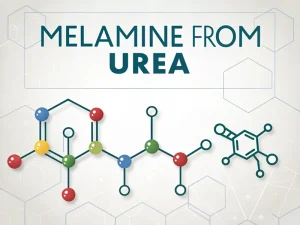
Melamine Packaging
Tech Blog Melamine packaging For manufacturers, inaccurate packaging not only fails to meet national standards but also increases labor costs and the risk of product

“Is urea toxic?” It is a very common question, and the answer is far more complex than a simple ‘yes’ or ‘no’.
Urea, as a chemical widely present in nature and industrial products – from skincare creams to fertilizers, and even as a metabolic product of the human body itself – has attracted much attention for its safety. It has extremely low toxicity for humans. But in certain specific situations, especially when ingested in large doses or used on particular animals, it may exhibit toxicity.
This article will delve into the toxicity of urea, providing you with a scientifically based and clear perspective.
To scientifically measure the toxicity of a substance, we usually use an indicator called the median lethal dose (LD50). It represents the dose that can cause the death of half of the tested animals. The higher the LD50 value, the lower the toxicity.
The LD50 (rat, oral) of urea is approximately 8471 mg/kg.
To make this number more meaningful, let’s compare the LD50 of several common substances:
Salt (sodium chloride):~3000 mg/kg;
Caffeine:~192 mg/kg;
Aspirin:~200mg/kg.
This comparison clearly indicates that the acute toxicity of urea is even lower than the salt we consume every day. This means that a very large dosage is required to cause serious harm to the human body.
Generally speaking, urea has low toxicity to humans, which is a key reason for its use in daily products. The reasons are as follows:
Low acute toxicity: Diluted with urea, it is non-corrosive or non-irritating. Ingesting small amounts (such as from skincare products or fertilizers) is unlikely to cause harm, although large doses may cause mild gastrointestinal discomfort (nausea, diarrhea).
Skin contact safety: Urea is a common ingredient in moisturizing creams, lotions, and foot creams. Its function is to attract water to the skin, softening dry or rough areas such as heels and elbows. Even at concentrations as high as 40% (medical grade products used to treat psoriasis or eczema), they are usually safe. However, some people with sensitive skin may feel a slight stinging sensation.
Inhalation non-toxic (diluted form): Inhaling small amounts of urea dust (such as fertilizer particles) is harmless to most people. However, high concentrations can irritate the nose, throat, or lungs, especially in asthma patients.
Although urea itself has low toxicity, certain conditions or exposures may cause problems:
High concentration: Consuming large amounts (such as industrial grade urea) can disrupt electrolyte balance, leading to vomiting, dizziness, or, in rare cases, kidney strain. This is more common when accidentally ingested by children or pets.
Ammonia release: When urea is heated or mixed with strong acids/bases, it decomposes into ammonia gas, an irritating and corrosive substance. Inhaling ammonia can burn the respiratory tract, eyes, and skin. This risk is highest in industrial environments (such as in urea fertilizer production or resin manufacturing processes).
Impurities in industrial urea: Fertilizers or industrial urea may contain heavy metals or contaminants such as urea, which may be toxic. For example, high levels of urea (a byproduct of urea synthesis) can irritate the skin or damage plants, but are harmless to humans in typical exposures.
Like humans, animals typically have tolerance to urea, but there are exceptions:
Principle: There are special microorganisms in the rumen of ruminants that can convert urea into protein. But if ingested too quickly or excessively, urea will soon decompose and produce a large amount of ammonia. When the rate of ammonia production exceeds the liver’s processing capacity, it can lead to ammonia poisoning, rapidly causing neurological symptoms (tremors, convulsions) and death.
Application: Despite its danger, urea is still used as an inexpensive non-protein nitrogen feed additive for ruminants. However, it must be mixed evenly with other feeds at strictly controlled doses.
If your pet licks a small amount of urea fertilizer scattered on the lawn, it usually only causes mild stomach discomfort. However, if they consume a large amount of fertilizer, it may cause severe vomiting and diarrhea. In addition, many fertilizers contain other chemicals that are more toxic to pets. If you suspect that your pet has ingested fertilizer, you should immediately contact a veterinarian.
Urea is relatively environmentally friendly, but excessive use can damage the ecosystem:
Water pollution: Excessive urea in agricultural runoff enters lakes, rivers, or oceans, promoting the proliferation of algae. These algal blooms deplete the oxygen in the water, killing fish and aquatic organisms, a process known as eutrophication.
Soil impact: High urea concentration in soil can temporarily increase the pH value, but this is reversible. Unlike synthetic insecticides, urea does not persist in soil or accumulate in the food chain.
In summary, urea itself is a low-toxicity compound for humans, and its safety depends on the dosage and exposure route. For daily skin contact, it is safe. Accidental ingestion of small amounts is usually not a big problem, but excessive ingestion requires medical attention.
The main toxicity risks are reflected in two aspects: excessive feeding of ruminant animals, such as cattle and sheep, is fatal, and their excessive presence in the environment can lead to eutrophication of water bodies.
Therefore, through responsible use and appropriate preventive measures, we can safely harness the enormous benefits of urea while minimizing its potential risks.
Is urea toxic in skincare products?
No. Skincare grade urea is highly purified and can be safely applied topically even at concentrations up to 40%.
Will urea kill plants?
Pure urea is a nitrogen fertilizer that helps plant growth, but excessive application or high urea content can burn plant roots.
Is urea toxic to fish?
Urea itself is not toxic to fish, but excessive runoff can lead to eutrophication, indirectly killing fish.

Tech Blog Melamine packaging For manufacturers, inaccurate packaging not only fails to meet national standards but also increases labor costs and the risk of product

Tech Blog How to Detect Melamine in Textiles? Melamine powder, a nitrogen-containing heterocyclic compound, is widely used in flame-retardant textiles and plastic products due to

Tech Blog melamine from urea Melamine is well-known for its wide range of applications, but its raw material for production is surprisingly urea. For manufacturers,

JINGJIANG MELAMINE POWDER
© JINJIANG MELAMINE